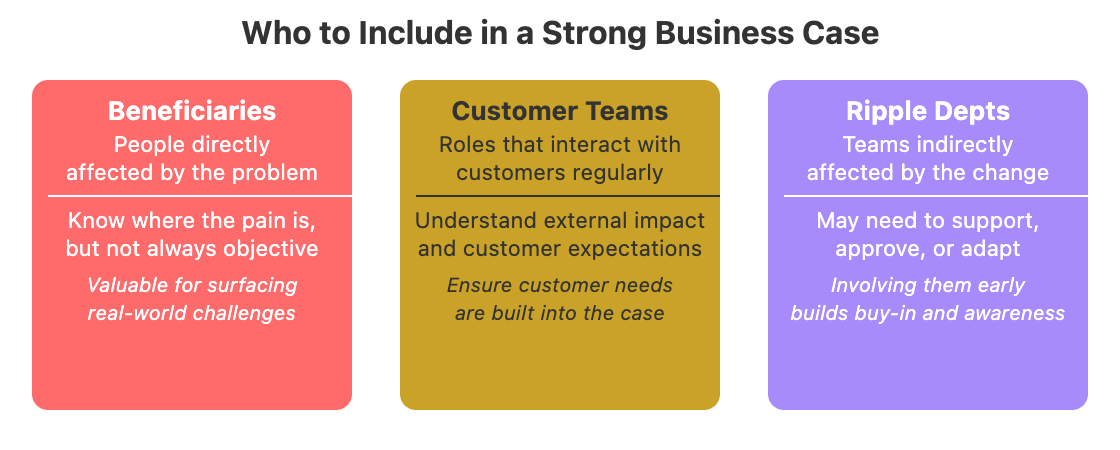Building a business case on your own is like trying to solve a complex puzzle while wearing blinders—you'll miss critical pieces that only become visible from different vantage points. The HBR Guide to Building Your Business Case by Raymond Sheen emphasizes that developing a business case is fundamentally a team effort. You need diverse perspectives to examine solutions from multiple angles, accurate financial projections from experts, and buy-in from the departments that will execute your solution.
Without a cross-functional team, your case risks reflecting only your department's viewpoint. For example, proposing a new inventory system without consulting warehouse teams, or projecting cost savings without finance validation, can lead to critical oversights. Both beneficiaries and subject-matter experts must help you determine the best solution, estimate realistic costs and benefits, and identify hidden risks.
Your team doesn't need to be a full-time, dedicated group. Instead, bring together experts from various departments at key points of the project, such as brainstorming alternatives, estimating financial impacts, or pressure-testing assumptions. This flexible approach respects everyone’s time while ensuring you get specialized input when needed.
When building cross-functional teams, it is important to bring in finance early, not as an afterthought. Many mistakenly see finance as the department that rejects proposals, but a finance representative is your strategic partner for establishing costs and making accurate projections.
Finance experts have a big-picture view of the company's revenues and expenses that you can't replicate on your own. Even if you’re comfortable with numbers, doing forecasting and ROI calculations by yourself can lead to embarrassing mistakes, like misunderstanding depreciation or personnel costs.
Consider this exchange:
- Ryan: How did the business case presentation go?
- Jessica: Not great. The CFO asked about depreciation schedules. I had no idea. Turns out I should have capitalized the $500,000 software licenses over three years instead of expensing them. My ROI was off.
- Ryan: When did you bring Victoria from finance onto your team?
- Jessica: I didn’t. I thought I could handle the numbers myself.
This shows why waiting too long to involve finance can derail your presentation. Finance partners help you navigate complex financial rules and provide insight into where money flows across functions, with access to historical data about similar projects. Their institutional knowledge helps you build realistic projections that won’t get quickly rejected in the boardroom.
Your business case must reflect impacts across the organization, so include those who will benefit from your solution and those who understand customer needs. There are three essential groups to include when building a strong business case: beneficiaries, customer-facing teams, and ripple departments. The diagram below summarizes the unique value each group brings to your team and why their perspectives are critical for a well-rounded proposal:

If you’re fixing a product defect, engineering might be your main beneficiary, but sales could also benefit from fewer customer complaints. Be sure to include representatives from each group, but avoid relying too heavily on beneficiaries for problem-solving. Since they are most affected by the issue, their perspective may be less objective. Their main contribution is to voice concerns and highlight pain points, rather than to develop the solution itself.
Customer-facing team members such as account managers, customer service reps, and marketing bring essential perspective about external impacts. Most new ideas affect customers, so this perspective is not optional.
Ideas rarely affect just one department. Overlooking ripple effects—such as how a new product impacts manufacturing, marketing, and sales—can lead to major oversights. By involving affected departments early, you can uncover important information that might otherwise be missed and, just as importantly, gain their support and buy-in. Stakeholders are much more likely to approve a proposal when they know their teams were involved in shaping it.
When forming your business case team, it’s important to resist the urge to include every possible stakeholder. Instead, keep your core group small. Generally core groups should consist of no more than six people. Including everyone slows momentum and focus. Large teams become unwieldy, and meetings devolve into endless debates.
Handpick core team members you work well with, those who are generous with their time and information. Then employ the "guest star" approach: add occasional contributors for specific purposes without bloating your core team.
For brainstorming, include creative colleagues as guest stars for one or two sessions. Invite supplier relations when evaluating vendor-dependent solutions, or a regulatory expert for compliance issues. This approach manages team dynamics and prevents territorial battles, as you can limit involvement to specific topics.
Your core team might include a finance representative, a key beneficiary, and a technical expert. Guest stars might be external consultants, vendors, or executives who clarify strategic constraints.
External experts are valuable guest stars, especially if your company hasn’t solved this type of problem before. Reach out to your network, online communities, vendors, and partners for crucial perspective. These external voices might join just one meeting, but their input can be the difference between a successful solution and a costly mistake.
In your upcoming role-play exercises, you’ll experience firsthand the dynamics of recruiting team members, managing perspectives, and balancing priorities—just like building your own cross-functional team for a real business case.
